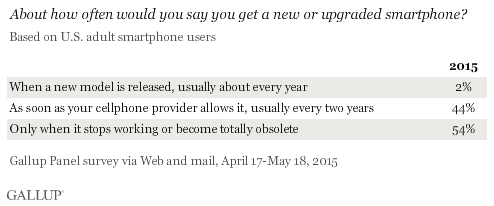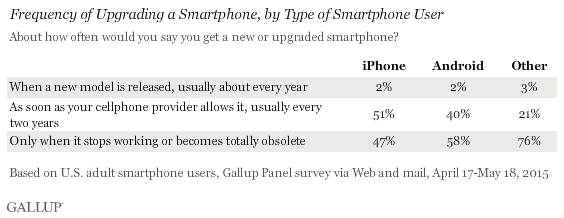Story Highlights
- 54% will upgrade only when phone stops working or is obsolete
- iPhone users more likely to upgrade as soon as possible
- Most Android and "other" smartphone users wait to upgrade
WASHINGTON, D.C. -- Smartphones may be rapidly increasing in popularity across America, but a majority (54%) of smartphone users say they will upgrade their phone "only when it stops working or becomes totally obsolete." This finding suggests that smartphone producers and mobile carriers have yet to convince the American public to upgrade frequently.

Forty-four percent of smartphone users say they will upgrade their model "as soon as your cellphone provider allows it, usually every two years." The major mobile carriers, such as AT&T, Verizon and Sprint, routinely offer users two-year contracts, with mobile subscribers often upgrading their devices after this time period. The major and minor carriers also offer phone service with no contracts and "pay as you go" plans, where the cost of the smartphone is initially more expensive, but not having to pay extra with an agreement mitigates the price of the phone.
Mobile carriers' attempts to entice customers to upgrade to new and "better" models more frequently is not yet catching on with smartphone users. A mere 2% say they upgrade their phone "when a new model is released, usually about every year."
These results are from a Gallup Panel survey conducted via the Web and mail in April and May with 15,766 U.S. adults who say they have a smartphone. The Gallup Panel is a probability-based sample with members in all 50 states.
In U.S., iPhone Users Upgrade More Frequently Than Android Users
Most U.S. smartphone users say they will upgrade only when their phone stops working or becomes obsolete, but there are differences between iPhone users and those who use Google's Android operating system. Fifty-one percent of iPhone users say they upgrade every two years, while 47% say only when their phone stops working or becomes obsolete. In contrast, 58% of Android users say they will wait until their phone stops working, with 40% saying they upgrade when eligible.

A reason for these differences among iPhone and Android users and reasons for upgrading could be income. Among those in households earning $75,000 or more per year, 55% own an iPhone, while 40% own an Android. Android users may not be as willing to upgrade because of the expense.
Users who have smartphones that fit into the "other" category, such as Windows phones, Blackberry phones or other smaller manufacturers, are much more likely to want to hold on to their phone until it breaks or become unusable. The 76% who say they do this is nearly four times higher than the 21% who say they upgrade every two years.
Bottom Line
Smartphones are becoming ubiquitous in the U.S. In less than a decade, the smartphone is on its way to becoming the dominant form of mobile telephone, with more technologically advanced models pushing the boundaries of what a telephone was once thought able to do.
While there may be zeal for owning a smartphone, Americans are divided in how frequently they upgrade their phones. It is apparent that despite aggressive marketing and media campaigns encouraging users to upgrade their phones to the hottest model, there is some resistance to switching out phones every year or two. Some mobile carriers offer incentives such as "pay as you go" plans or no contracts at all, but it remains to be seen whether these methods -- or newer, more creative forms of marketing -- will have a lasting influence on the purchasing habits of smartphone users across the U.S.
Survey Methods
Results are based on 15,766 members of the Gallup Panel who have smartphones, conducted April 17-May 18, 2015. The sample for this study was weighted to be demographically representative of the U.S. adult population, using 2012 Current Population Survey figures. For results based on this sample, one can say that the margin of sampling error is ±1 percentage point at the 95% confidence level.
For results based on the total samples of 8,234 iPhone users and 6,072 Android users, the margin of sampling error is ±1 percentage point at the 95% confidence level.
For results based on the total samples of 1,105 other (non-iPhone, non-Android) smartphone users, the margin of sampling error is ±4 percentage points at the 95% confidence level.
All reported margins of sampling error include computed design effects for weighting. In addition to sampling error, question wording and practical difficulties in conducting surveys can introduce error or bias into the findings of public opinion polls.
Learn more about how the Gallup Panel works.

